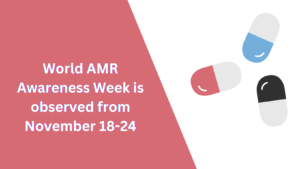
The eighteenth through twenty-fourth of November, 2023 is designated as World Antimicrobial Resistance Awareness Week.
The purpose of this week is to raise awareness and knowledge of antimicrobial resistance (AMR) while simultaneously advocating for better practices across One Health stakeholders.
The major objective is to reduce the number of diseases that are resistant to drugs and the transmission of those infections.
“Preventing Antimicrobial Resistance Together” is the theme of this essay.
The chosen subject for the World Antimicrobial Awareness Week in 2023 will be “Preventing Antimicrobial Resistance Together,” which is the same as the theme that was selected for the previous year, 2022.
All aspects of our linked world are being impacted by antimicrobial resistance (AMR), which poses a huge threat to all living things, including humans, animals, plants, and the environment.
This year’s topic emphasizes the necessity of coordinated efforts across a variety of industries to achieve the goal of protecting the effectiveness of antimicrobials.
There is a growing danger to vulnerable populations posed by the adaptation of microorganisms and the resistance of antimicrobials.
- To protect themselves from antimicrobial drugs such as antibiotics and antivirals, microbes can make adjustments and establish defense mechanisms.
- Antimicrobials become less effective as a result of this adaptation process, which makes it more difficult to treat infections.
- Particularly in danger are vulnerable populations, such as people whose immune systems have been compromised as a result of illnesses such as cancer or surgical treatments.
The Influence of AMR on the World
According to the United Nations Environment Programme (UNEP), if antimicrobial resistance (AMR) is not addressed, it has the potential to cause 24 million people to fall into severe poverty within the next ten years and cost trillions of dollars in lost gross domestic product.
Those Responsible for AMR
- Although antimicrobial resistance (AMR) is a natural phenomenon, several circumstances can speed up its growth. These causes include the excessive use of antimicrobials and their improper usage in the health of both humans and animals.
- A significant portion of the antibiotics that are sold around the world are destined for the agricultural sector, which accounts for around 70 percent of the total.
- In many regions of the world, practices such as the routine use of antibiotics in livestock feed continue to be prevalent, which contributes to the difficulty of the situation.
Solutions that are Complicated for a Complicated Crisis
Challenges in the pharmaceutical sector make it difficult to address antimicrobial resistance (AMR). As a result of high production costs and uncertain earnings, major businesses are progressively giving up on the development of antibiotics.
When it comes to prescribing new antibiotics, medical professionals are confronted with ethical difficulties, while governments strive to maintain low drug pricing, which inevitably leads to increasing competition and the possibility of environmental degradation.
Increasing Collaboration to Achieve Effective Solutions
This fight against antimicrobial resistance requires collaboration between different areas and industries. In addition to patients and medical experts, hospitals, wastewater treatment plants, and pharmaceutical manufacturers should all be involved in the discussion and collaboration.
When it comes to the implementation of legislation, the provision of money, and the promotion of collaboration among various stakeholders, governments play a significant role.










